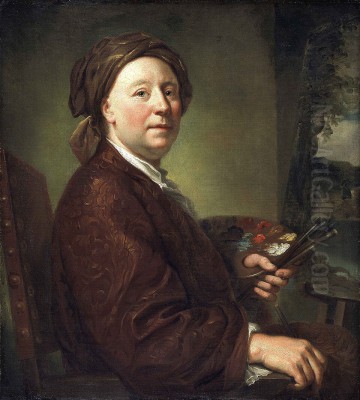
Richard Wilson stands as a pivotal figure in the history of British art. Born in Wales in 1714 and passing away in 1782, his life spanned a crucial period of artistic development in Britain. He is widely celebrated, and justly so, as the "Father of British Landscape Painting." Wilson's primary achievement was to elevate landscape from mere topographical record or decorative backdrop to a genre capable of expressing profound emotion and classical ideals, paving the way for subsequent generations of celebrated artists. His unique vision synthesized the grandeur of continental traditions, particularly those of Italy, with the specific character of the British, and especially Welsh, countryside.
Early Life and Artistic Beginnings
Richard Wilson entered the world in the small village of Penegoes, Montgomeryshire, Wales. His father served as the local clergyman, a man of the church connected to respectable society. Wilson's mother belonged to the influential Wynn family of Leeswood, Flintshire, providing the young artist with connections that might have initially suggested a different path. However, his artistic inclinations surfaced early.
Around 1729, Wilson moved to London, the burgeoning centre of British artistic life. He secured an apprenticeship with a portrait painter named Thomas Wright. While Wright remains a somewhat obscure figure today, he provided Wilson with the foundational skills of drawing and painting. During this period, Wilson focused on portraiture, the most commercially viable genre for an aspiring artist in 18th-century Britain.
He demonstrated considerable talent in capturing likenesses and achieved a degree of success. His sitters included members of the aristocracy and prominent figures, such as portraits commissioned of the Prince of Wales and the Duke of York. Another notable early work was a portrait of Dr. Francis Ayscough with his pupils. These early successes indicated a promising career in portrait painting lay before him, following the conventional route for ambitious British artists of the time. Yet, Wilson's destiny lay elsewhere, amidst the landscapes that would capture his imagination.
The Italian Transformation: A New Vision

The turning point in Richard Wilson's career arrived with his journey to Italy, a pilgrimage considered almost essential for aspiring artists and cultured gentlemen of the era – the Grand Tour. Wilson departed in 1750 and remained abroad, primarily in Venice and Rome, until 1757. This extended period immersed him in the art, culture, and, crucially, the landscapes that had inspired painters for centuries.
In Venice, he encountered the vibrant contemporary art scene. It was here, or possibly shortly after arriving in Rome, that a significant encounter occurred. According to accounts, the Italian landscape painter Francesco Zuccarelli, known for his charming and somewhat decorative pastoral scenes, saw one of Wilson's landscape studies. Zuccarelli, along with perhaps the French painter Claude Joseph Vernet, strongly advised Wilson to abandon portraiture and dedicate himself entirely to landscape painting, recognizing his innate talent for the genre.
This advice resonated deeply with Wilson. Rome and its surrounding countryside, the Campagna, proved particularly inspirational. He absorbed the lessons of the great masters of classical landscape painting whose works were revered and studied by visiting artists. Foremost among these was the 17th-century French painter Claude Lorrain, whose idealized depictions of the Roman Campagna, bathed in golden light and structured with classical architecture and mythological figures, became a touchstone for Wilson.
He also studied the works of Claude's contemporaries, Nicolas Poussin and Gaspard Dughet (also known as Gaspard Poussin), who similarly employed classical principles of composition and idealized nature. The more dramatic, untamed landscapes of the Italian painter Salvator Rosa also left their mark, offering an alternative vision of nature as wild and sublime. During his time in Italy, Wilson associated with other British artists on the Grand Tour, including the landscape painter George Lambert and the topographical artist Samuel Scott, sharing experiences and absorbing the artistic atmosphere. He may also have encountered the work of view painters like Canaletto (Giovanni Antonio Canal), though Wilson's aims were less topographical and more poetic.
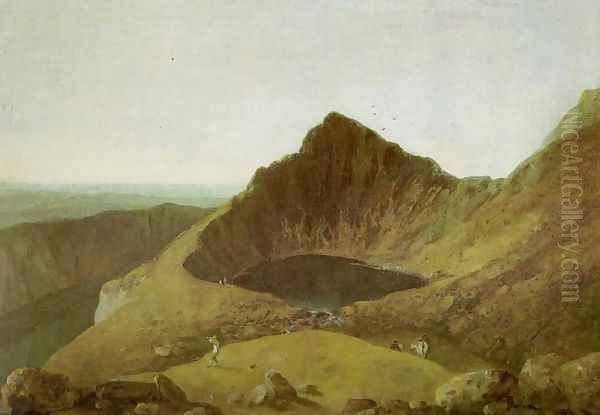
Wilson diligently sketched and painted outdoors, capturing the light, atmosphere, and ancient ruins of the Italian landscape. He developed a style characterized by balanced compositions, often framed by trees, leading the viewer's eye into luminous distances. His palette captured the warm glow of the Italian sun, and his handling of paint became more fluid and expressive. Works like The Alban Hills exemplify this period, showcasing his mastery of atmospheric perspective and his ability to imbue a scene with a sense of timeless classical serenity. This Italian sojourn fundamentally reshaped his artistic identity and equipped him with the vision and technique to revolutionize landscape painting back home.
Return to Britain: Forging a National Landscape Style
Upon returning to Britain in 1757, Richard Wilson brought with him a fully formed classical landscape style, deeply indebted to Claude Lorrain and the Italian tradition, yet poised for adaptation. London, however, was not immediately receptive to his new direction. While topographical views and sporting scenes found ready buyers, idealized landscapes rooted in classical principles were less understood and commercially valued than portraiture.
Despite this initial coolness, Wilson's talent and innovative approach gradually gained recognition within artistic circles. A landmark event was the founding of the Royal Academy of Arts in London in 1768. Wilson was nominated as one of the original members, a testament to his standing among his peers, which included figures like Sir Joshua Reynolds, the Academy's first president, and Thomas Gainsborough, another artist exploring landscape, albeit often in a less purely classical vein. This membership provided prestige and a vital platform for exhibiting his work annually.
Wilson began to apply the compositional structures and atmospheric effects learned in Italy to British, particularly Welsh, scenery. He did not merely record the views before him; instead, he sought to elevate them, finding the universal and poetic within the specific. His paintings often feature carefully balanced compositions, serene light, and a palpable sense of atmosphere, whether depicting the ruins of a Welsh castle or a tranquil river valley.
His technique involved subtle gradations of tone to create depth and a masterful handling of light to evoke mood, often favouring the gentle light of early morning or late afternoon. He synthesized direct observation of nature with the classical principles of order and harmony inherited from Claude Lorrain and Gaspard Dughet. This fusion created a distinctly British form of classical landscape that moved beyond simple imitation of continental models.
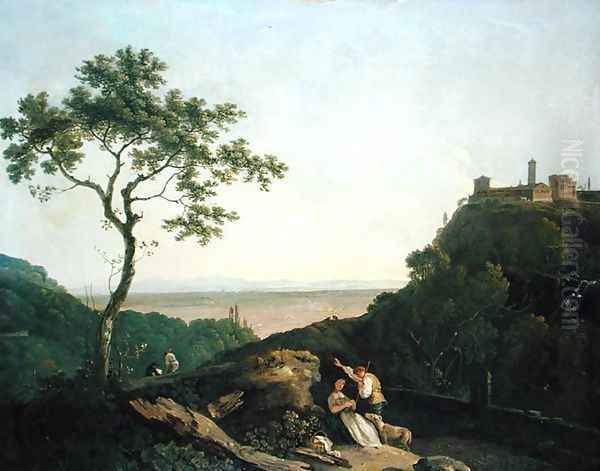
A significant work from this period is The Destruction of the Children of Niobe, exhibited in 1760. This large, dramatic canvas depicted a mythological subject within a turbulent, sublime landscape, directly engaging with the tradition of historical landscape painting established by Poussin and Rosa. It was a bold statement, asserting landscape's capacity to convey grand themes and powerful emotions, comparable to the more esteemed genre of history painting. While ambitious, such works found fewer buyers than his more tranquil views.
Depicting Wales: Idealism Meets Native Scenery
While Wilson continued to paint Italianate scenes throughout his career, often based on sketches made during his travels, a significant portion of his output after returning to Britain focused on the landscapes of his native Wales. This engagement with Welsh scenery is central to his legacy and represents a crucial step in the development of a national school of landscape painting.
Wilson approached the mountains, valleys, lakes, and castles of Wales not as a topographical recorder but as a poet seeking the inherent grandeur and classical potential within the landscape. He applied the compositional strategies and atmospheric sensitivity honed in Italy to subjects like Snowdon, Cader Idris, Caernarfon Castle, Dolbadarn Castle, and the River Wye.
In paintings such as Snowdon from Llyn Nantlle or Cader Idris: Llyn-y-Cau, Wilson captures the specific character of the Welsh mountains but filters it through his classical lens. He organizes the potentially chaotic forms of nature into balanced, harmonious compositions. Light plays a crucial role, often bathing the scene in a soft, unifying glow, reminiscent of Claude Lorrain, yet adapted to the cooler, more variable light of Britain. He sought the picturesque and the sublime in his native land, finding parallels between the rugged Welsh terrain and the dramatic landscapes of Salvator Rosa or the tranquil beauty of the Roman Campagna.
Works like Caernarfon Castle or Pembroke Town and Castle demonstrate his ability to integrate architectural elements seamlessly into the landscape, lending them a timeless, almost Arcadian quality. He wasn't interested in precise architectural rendering but in the way these structures interacted with the surrounding natural forms, light, and atmosphere. These Welsh landscapes were innovative because they treated native scenery with the same seriousness and artistic ambition previously reserved for Italian views or mythological subjects. Wilson demonstrated that British landscapes were worthy subjects for high art.
His depictions of Wales profoundly influenced how subsequent generations of artists viewed and painted the British countryside. He revealed the artistic potential of familiar scenery, encouraging artists to look closer at their own environment while still drawing upon the rich traditions of European landscape painting.
Challenges, Patronage, and Later Life
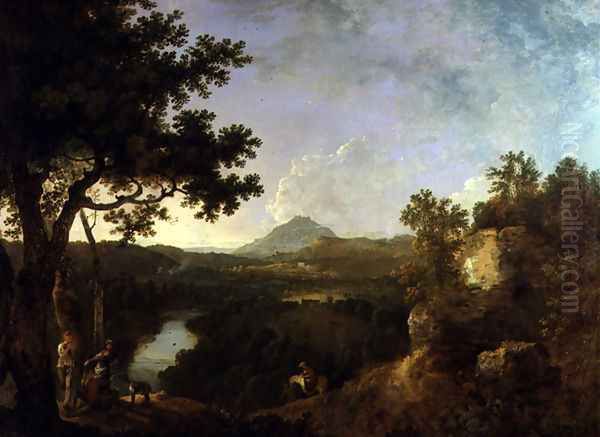
Despite his undeniable talent, foundational role at the Royal Academy, and the eventual recognition of his importance, Richard Wilson faced significant financial difficulties throughout much of his later career. The market for his specific brand of idealized landscape painting remained limited in Britain during his lifetime. Portraiture, dominated by figures like Reynolds and Gainsborough, continued to be the most lucrative genre.
Patrons often preferred more literal, topographical views of their estates or recognizable locations, rather than Wilson's classically inspired, sometimes composite, landscapes which prioritized mood and composition over strict accuracy. While he received some important commissions, consistent patronage proved elusive. His personality may also have played a role; contemporary accounts suggest he could be proud, somewhat blunt, and perhaps unwilling to compromise his artistic vision for commercial demands.
His financial struggles became acute enough that in 1776, his fellow Academicians appointed him Librarian of the Royal Academy. This position carried a modest stipend, offering some measure of financial relief in his later years, though it was seen by some as a somewhat charitable act towards a respected but impoverished colleague.
Towards the end of his life, Wilson's health declined. He eventually left London and returned to Wales, spending his final years living with relatives at Colomendy Hall near Llanferres in Denbighshire. It was here, amidst the landscapes he had so often painted, that he passed away in 1782. His death occurred in relative obscurity, his true significance not fully appreciated until later generations, particularly the Romantics, recognized the profound impact of his work.
Artistic Influences and Contemporaries
Richard Wilson's art was shaped by a confluence of influences and developed in dialogue with the artistic currents of his time. His initial training under Thomas Wright grounded him in the practice of portraiture, the dominant British genre. The crucial shift came through the advice of Francesco Zuccarelli and possibly Claude Joseph Vernet in Italy, steering him towards landscape.
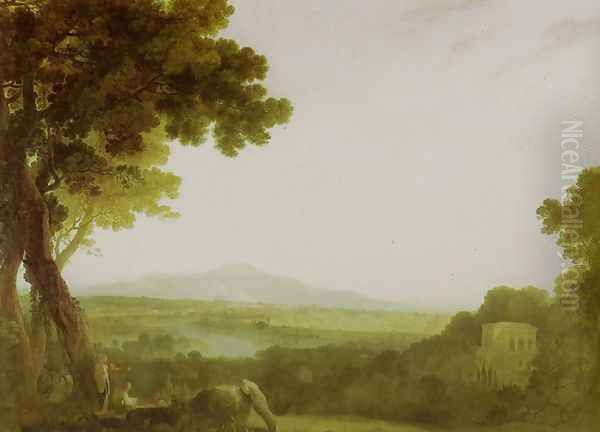
The most profound influences on his landscape style were the 17th-century masters of the classical tradition: Claude Lorrain, whose idealized compositions and mastery of light became Wilson's guiding star; Gaspard Dughet, known for his structured depictions of the Roman Campagna; and Nicolas Poussin, whose historical landscapes provided a model for integrating narrative and elevated themes. The wilder, more dramatic vision of Salvator Rosa also informed Wilson's approach to sublime aspects of nature. Earlier Dutch landscape painters like Aelbert Cuyp, with his sensitivity to light, and perhaps Jacob van Ruisdael, may also have offered lessons, though the Italianate classical tradition was paramount.
Among his British contemporaries, George Lambert shared Wilson's interest in landscape and is sometimes considered a parallel pioneer, though Wilson's Italian experience gave his work a distinct classical authority. Samuel Scott specialized in topographical views and river scenes, representing a different, more literal approach to landscape. Thomas Gainsborough, while primarily a portraitist, also painted landscapes throughout his career, often with a lighter, more feathery touch and a Rococo sensibility, contrasting with Wilson's more solid, classical structures. Sir Joshua Reynolds, as President of the Royal Academy, represented the pinnacle of portrait painting and history painting, the genres Wilson ultimately moved away from but whose status influenced the context in which Wilson worked. The work of view painters like Canaletto, popular among Grand Tourists, provided a backdrop of detailed topographical representation against which Wilson's idealized approach stood out.
Wilson's unique contribution was to synthesize these various influences – the classical structure of Claude and Dughet, the atmospheric light observed in Italy and Britain, and a poetic sensibility – into a style that was both rooted in tradition and distinctively his own, laying the groundwork for a truly British school of landscape.
Pupils and Enduring Legacy
Although Richard Wilson did not run a large, formal studio in the manner of some contemporaries, he did take on pupils who absorbed his methods and approach to landscape. Among the most notable were Thomas Jones (1742-1803) and Joseph Farington (1747-1821). Thomas Jones, also Welsh, followed Wilson to Italy and produced remarkable oil sketches directly from nature, demonstrating a fresh, observational approach perhaps partly inspired by Wilson's own working methods, though Jones's sketches possess a unique immediacy. Farington became a Royal Academician and a diligent diarist, whose writings provide invaluable insights into the London art world of the late 18th and early 19th centuries, including details about Wilson himself.
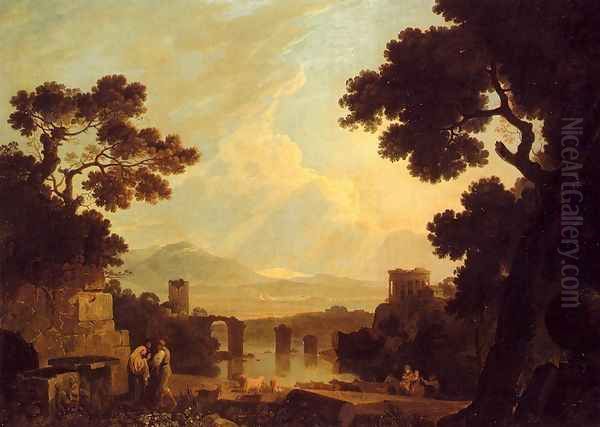
Wilson's true legacy, however, extends far beyond his direct pupils. His fundamental achievement was to establish landscape painting as a serious, respected genre in Britain, capable of conveying complex ideas and emotions. He demonstrated that British scenery could be treated with the same artistic dignity as the revered landscapes of Italy. By adapting the classical landscape tradition to British subjects and light, he provided a crucial foundation upon which the next generation could build.
His influence is clearly discernible in the work of the giants of British Romantic landscape painting: J.M.W. Turner (1775-1851) and John Constable (1776-1837). Turner, in his early work, directly emulated Wilson's classical compositions and atmospheric effects before developing his own revolutionary style. Constable, while focused on a more naturalistic depiction of the English countryside, acknowledged Wilson's importance in elevating the status of landscape art. Both artists, in different ways, built upon the territory Wilson had opened up.
The title "Father of British Landscape Painting" is therefore not mere hyperbole. Wilson fundamentally shifted the perception and practice of landscape art in Britain. He introduced a poetic, idealized approach learned from continental masters, applied it to both Italian and British scenes, and inspired subsequent artists to explore the expressive potential of the natural world. Though underappreciated commercially during his lifetime, his artistic vision proved enduringly influential.
Analysis of Key Works
Examining specific paintings reveals the core characteristics of Wilson's art. The Alban Hills (c. 1750s), painted during or shortly after his Italian stay, perfectly encapsulates his Claudian ideal: a serene, balanced composition, framed by trees, leading the eye towards distant mountains bathed in warm, hazy light, with small figures adding scale and a touch of pastoral life.
The Destruction of the Children of Niobe (1760) showcases a different facet: the historical landscape. Here, Wilson employs a dramatic, stormy setting influenced by Salvator Rosa and Gaspard Dughet to heighten the mythological tragedy. Jagged rocks, wind-swept trees, and turbulent skies create a sublime backdrop for the unfolding drama, demonstrating landscape's power to amplify narrative.
His Welsh landscapes, such as Caernarfon Castle (various versions), integrate the iconic structure into an idealized natural setting. The castle is presented not just as a historical monument but as a harmonious element within a carefully composed view, often under the soft light of morning or evening, evoking a sense of timelessness and picturesque beauty.
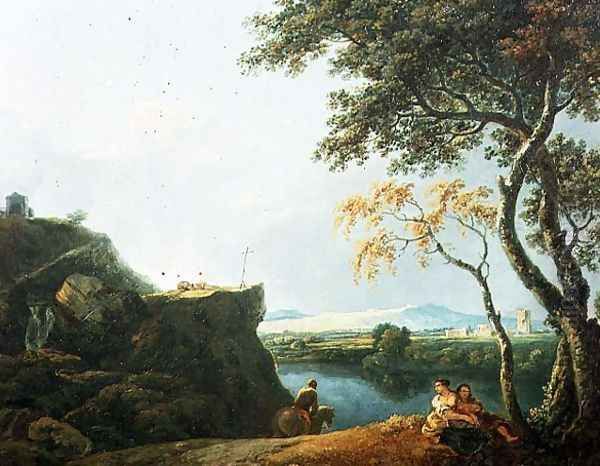
View at Tivoli (c. 1760s) returns to an Italian subject, likely based on sketches. It depicts the famous temple and waterfall, but again, the focus is less on topographical accuracy and more on the classical composition, the interplay of light and shadow on the ruins and water, and the overall poetic mood – a distillation of the Italian experience.
Cader Idris: Llyn-y-Cau (c. 1774) is a powerful late Welsh landscape. It depicts the mountain lake with a sense of grandeur and solitude. While recognizably Welsh, the scene is imbued with a classical structure and a sublime atmosphere, demonstrating Wilson's mature ability to find universal artistic themes within his native landscape. The handling of light and the vast scale convey a profound sense of nature's majesty.
Across these works, common threads emerge: a foundation in classical composition derived from Claude Lorrain and Gaspard Dughet, a profound sensitivity to light and atmosphere, an ability to idealize nature without losing its essential character, and a consistent aim to evoke mood and poetic feeling rather than simply record appearances.
Conclusion: A Lasting Foundation
Richard Wilson's career represents a crucial bridge in British art history. He inherited the traditions of continental landscape painting, particularly the idealized classical mode, and masterfully adapted them to both Italian and British subjects. While initially trained as a portraitist, his transformative experience in Italy set him on a path to redefine landscape painting in Britain, elevating it from a minor genre to one capable of profound artistic expression.
As a founding member of the Royal Academy, he helped institutionalize landscape painting, even as he struggled for personal financial success. His depictions of Wales were particularly groundbreaking, demonstrating that native scenery could be treated with the same artistic seriousness as the revered landscapes of the Roman Campagna. His emphasis on balanced composition, atmospheric light, and poetic mood laid an essential foundation for the future development of British landscape art.
Though perhaps overshadowed in popular recognition by his successors, Turner and Constable, Wilson's pioneering role is undeniable. He provided the essential vocabulary and raised the artistic status of landscape painting, enabling the great flourishing of the genre in the Romantic era. Richard Wilson remains a seminal figure, truly the "Father of British Landscape Painting," whose influence permeates the subsequent history of art in Britain.